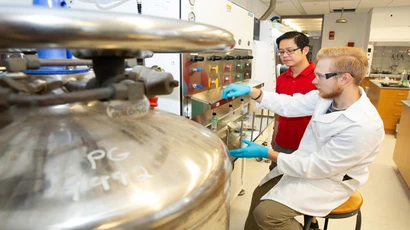
Chemistry Department Equipment
Shimadzu HPLC with diode array/single quad MS detector
Description: High-Performance Liquid Chromatography (HPLC) is the most important technique for the separation and analysis of complex mixtures such as those collected from biological or environmental sources. It is widely used in pharmaceutical and environmental research. The technique is suitable for non-volatile analytes, and thus compliments Gas Chromatography (GC).
Shimadzu GCMS-TQ8030 Gas Chromatograph/Mass Spectrometer
Description: This instrument is the most recent state-of-the-art gas chromatograph/mass spectrometer offered by the Shimadzu Corporation, and it is a highly versatile, robust, instrument that can be used in many different modes. This instrument is particularly well-suited for the analysis of trace compounds in complex matrices, as often encountered in forensic, environmental, and biochemical analyses. In addition, this instrument has a direct inlet probe, allowing the bypassing of the gas chromatograph. As a result, it can be used as a stand-alone mass spectrometer in either the single quadrapole (MS) or MS/MS mode.
Shimadzu GC-2014 Gas Chromatograph
Description: This gas chromatograph is a classic “work-horse” instrument that is designed for high-throughput analysis and robust dependability. It can be operated to accommodate packed, megabore capillary, and true capillary columns depending on the separation needs. In addition, three different types of detectors can be employed: thermal conductivity (TCD), flame ionization (FID), and electron capture (ECD). The result is a highly flexible instrument that can be used in a variety of different configurations.
Bruker FTIR Spectrometer
Description: FTIR spectroscopy is an essential analytical technique in synthetic and analytical chemistry, where it is used to identify or characterize virtually any molecular compound. FTIR is used in instructional labs for organic, inorganic, instrumental analysis and physical chemistry.
Bruker Avance III HD 500 MHz NMR Spectrometer
Description: Nuclear Magnetic Resonance (NMR) is the most important experimental technique for the structural characterization of molecules. The technique is particularly important for structural studies of biologically-derived molecules (for example proteins, nucleic acids, and carbohydrates).
Anasazi EFT 90 MHz NMR Spectrometer
Description: Low-field NMR spectroscopy provides structural information for routine organic and inorganic samples, such as those deriving from student syntheses. It is heavily used in graduate programs and in chemical and pharmaceutical industries.
Shimadzu ICPE-9000 Plasma Emission Spectrometer
Description: This instrument is designed for high sensitivity analysis of virtually all the metals and many of the metalloids on the periodic table. This highly versatile and easy to use instrument has applications in material sciences, forensics, environmental sciences, biology and biochemistry, and in the petroleum industry.
Microwave Reactor Oven
Description: Oven that heats chemical reactions using microwave radiation. Enables reactions to be performed in a shorter time period using less energy.
Shimadzu UV-Vis spectrometers
Description: Instrument is commonly used to quantify the amounts of materials in a solution and to monitor the rate of chemical reactions. It does this by measuring the wavelength of light that the compounds absorb. This instrument Is used in almost every aspect of chemistry, biochemistry and molecular biology.
MBRAUN MB-SPS-800 Solvent Purification System
Description: The MB-SPS-800 can be configured up to 7 solvents and is designed specifically for laboratories that need a safe, fast and easy method for dispensing ultra-dry solvents. Unique features include glovebox integration ready double column filtration, 17 liter solvent reservoir and independent regulators for each solvent line.
MBraun Inert Atmosphere Box
Description: Inert atmosphere boxes are used to handle any material which is sensitive to air or moisture. They are widely used in industry and research labs. Newer boxes incorporate a solvent purification system which avoids the dangerous process of solvent distillation and transfer previously required.
Reichert Surface Plasmon Resonance spectrometer (SPR)
Description: SPR is used in pharmaceutical development, drug discovery, antibody screening, protein structure and function, gene regulation, and systems biology. SPR uses a label-free detection of molecular interactions and presents an attractive alternative to traditional label-based techniques such as fluorescence.
Bruker Venture single-crystal X-ray diffractometer
Description: X-ray: A definitive technique to determine molecular structure, with significant applications in geoscience. X-ray structure determinations are becoming increasingly routine and have uses in applications where knowledge of molecular structure is important e.g., synthesis and biomolecules. X-ray would be used in organic, inorganic, instrumental, geoscience and biochemistry labs. It is also an ideal instrument to display during an open house or on the website, since its output is a “picture” of a molecule, which requires no special training to interpret, in marked contrast to the output of other instruments X-ray facilities at Fredonia would better prepare our students for opportunities at those and other institutions and would allow continuing collaboration between Fredonia and other institutions, e.g., Fredonia students who participate in an REU could perform their structures here.
Shimadzu MALDI-TOF Mass Spectrometer
Description: MALDI: A form of mass spectroscopy, a technique that has many variations and has become quite common and routine. It is useful to characterize or identify compounds in all fields of chemistry.
Combi-Flash Chromatography System
Description: this instrument is similar to the HPLC system but is designed for larger scale separations. It is a self contained system that monitors the separation using UV-Vis detection and separates the components into individual test tubes. It is routinely used in synthetic organic labs to isolate the product from a reaction mixture. The system is designed to conserve solvent by controIling the flow of solvent and monitoring when the product has been isolated.
